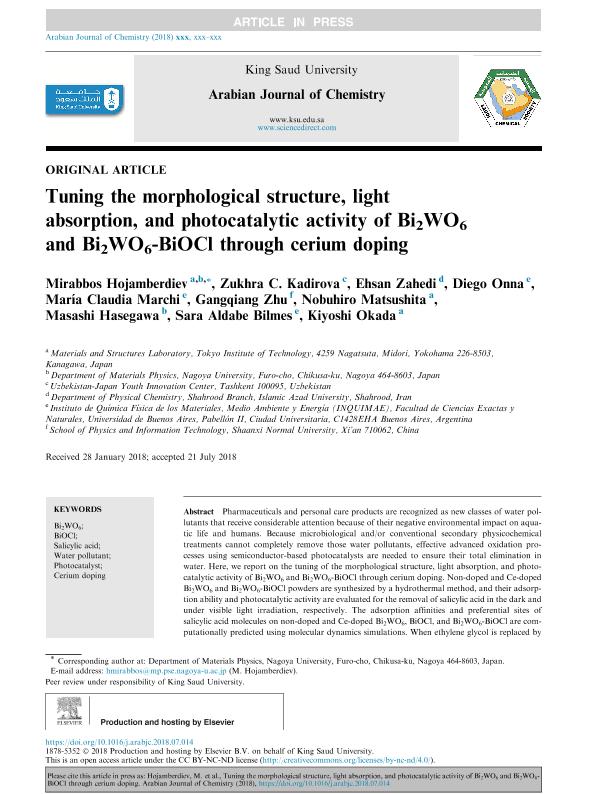Mostrar el registro sencillo del ítem
dc.contributor.author
Hojamberdiev, Mirabbos

dc.contributor.author
Kadirova, Zukhra C.
dc.contributor.author
Zahedi, Ehsan
dc.contributor.author
Onna, Diego Ariel

dc.contributor.author
Marchi, María Claudia

dc.contributor.author
Zhu, Gangqiang
dc.contributor.author
Matsushita, Nobuhiro
dc.contributor.author
Hasegawa, Masashi
dc.contributor.author
Aldabe, Sara Alfonsina

dc.contributor.author
Okada, Elena

dc.date.available
2019-10-17T13:53:33Z
dc.date.issued
2018-07
dc.identifier.citation
Hojamberdiev, Mirabbos; Kadirova, Zukhra C.; Zahedi, Ehsan; Onna, Diego Ariel; Marchi, María Claudia; et al.; Tuning the morphological structure, light absorption, and photocatalytic activity of Bi2WO6 and Bi2WO6-BiOCl through cerium doping; Elsevier; Arabian Journal of Chemistry; 11; 7-2018; 1-14
dc.identifier.issn
1878-5352
dc.identifier.uri
http://hdl.handle.net/11336/86140
dc.description.abstract
Pharmaceuticals and personal care products are recognized as new classes of water pollutants that receive considerable attention because of their negative environmental impact on aquatic life and humans. Because microbiological and/or conventional secondary physicochemical treatments cannot completely remove those water pollutants, effective advanced oxidation processes using semiconductor-based photocatalysts are needed to ensure their total elimination in water. Here, we report on the tuning of the morphological structure, light absorption, and photocatalytic activity of Bi2WO6 and Bi2WO6-BiOCl through cerium doping. Non-doped and Ce-doped Bi2WO6 and Bi2WO6-BiOCl powders are synthesized by a hydrothermal method, and their adsorption ability and photocatalytic activity are evaluated for the removal of salicylic acid in the dark and under visible light irradiation, respectively. The adsorption affinities and preferential sites of salicylic acid molecules on non-doped and Ce-doped Bi2WO6, BiOCl, and Bi2WO6-BiOCl are computationally predicted using molecular dynamics simulations. When ethylene glycol is replaced by dilute HCl as a solvent in a hydrothermal system, BiOCl is also formed along with Bi2WO6, confirming the successful formation of a Bi2WO6-BiOCl composite. The flower-like hierarchical structures of Bi2WO6 and Bi2WO6-BiOCl can absorb more photon energy due to multiple scattering, charge carriers can easily transfer to the surface/interface, and mesopores can improve the transfer rate of organic molecules, contributing to the overall enhancement in photocatalytic activity. The Bi2WO6-BiOCl samples show higher photocatalytic activity than that of the Bi2WO6 samples for the degradation of salicylic acid due to the formed p–n heterojunction. The optimum concentration of Ce doping is found to be 1 mol% in the Bi2WO6 and Bi2WO6-BiOCl, promoting the effective separation and transfer of photogenerated charge carriers, resulting in high photocatalytic performance, and the sample exhibited good stability.
dc.format
application/pdf
dc.language.iso
eng
dc.publisher
Elsevier
dc.rights
info:eu-repo/semantics/openAccess
dc.rights.uri
https://creativecommons.org/licenses/by-nc-sa/2.5/ar/
dc.subject
BI2WO6
dc.subject
BIOCL
dc.subject
CERIUM DOPING
dc.subject
PHOTOCATALYST
dc.subject
SALICYLIC ACID
dc.subject
WATER POLLUTANT
dc.subject.classification
Nano-materiales

dc.subject.classification
Nanotecnología

dc.subject.classification
INGENIERÍAS Y TECNOLOGÍAS

dc.subject.classification
Nano-materiales

dc.subject.classification
Nanotecnología

dc.subject.classification
INGENIERÍAS Y TECNOLOGÍAS

dc.title
Tuning the morphological structure, light absorption, and photocatalytic activity of Bi2WO6 and Bi2WO6-BiOCl through cerium doping
dc.type
info:eu-repo/semantics/article
dc.type
info:ar-repo/semantics/artículo
dc.type
info:eu-repo/semantics/publishedVersion
dc.date.updated
2019-10-16T15:23:16Z
dc.journal.volume
11
dc.journal.pagination
1-14
dc.journal.pais
Países Bajos

dc.journal.ciudad
Amsterdam
dc.description.fil
Fil: Hojamberdiev, Mirabbos. Tokyo Institute Of Technology; Japón
dc.description.fil
Fil: Kadirova, Zukhra C.. Uzbekistan-japan Youth Innovation Center; Uzbekistán
dc.description.fil
Fil: Zahedi, Ehsan. Islamic Azad University; Irán
dc.description.fil
Fil: Onna, Diego Ariel. Universidad de Buenos Aires. Facultad de Ciencias Exactas y Naturales. Departamento de Química Inorgánica, Analítica y Química Física; Argentina
dc.description.fil
Fil: Marchi, María Claudia. Universidad de Buenos Aires. Facultad de Ciencias Exactas y Naturales. Departamento de Química Inorgánica, Analítica y Química Física; Argentina
dc.description.fil
Fil: Zhu, Gangqiang. Shaanxi Normal University; China
dc.description.fil
Fil: Matsushita, Nobuhiro. Nagoya University; Japón
dc.description.fil
Fil: Hasegawa, Masashi. Tokyo Institute Of Technology; Japón
dc.description.fil
Fil: Aldabe, Sara Alfonsina. Universidad de Buenos Aires. Facultad de Ciencias Exactas y Naturales. Departamento de Química Inorgánica, Analítica y Química Física; Argentina
dc.description.fil
Fil: Okada, Elena. Tokyo Institute Of Technology; Japón
dc.journal.title
Arabian Journal of Chemistry
dc.relation.alternativeid
info:eu-repo/semantics/altIdentifier/url/https://www.sciencedirect.com/science/article/pii/S187853521830162X
dc.relation.alternativeid
info:eu-repo/semantics/altIdentifier/doi/http://dx.doi.org/10.1016/j.arabjc.2018.07.014
Archivos asociados
